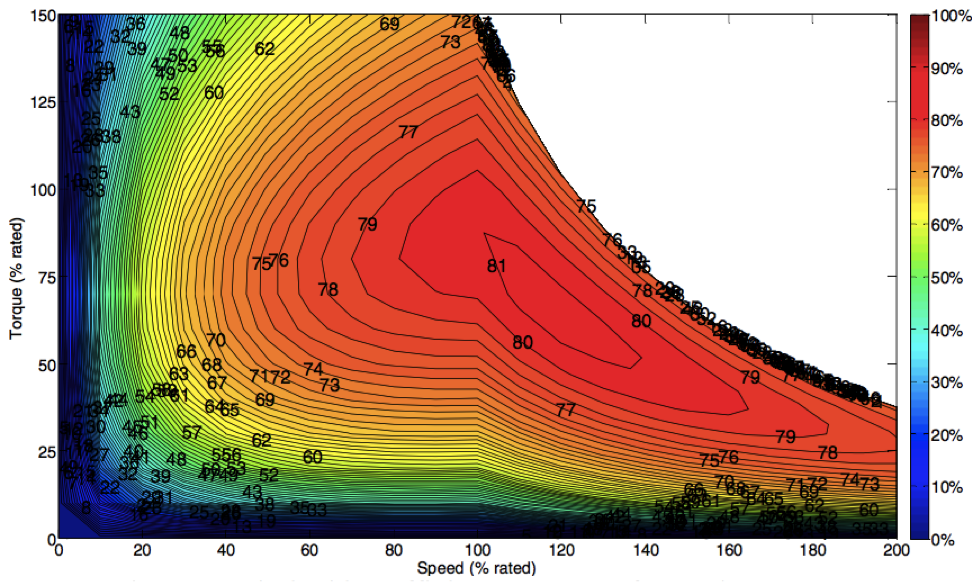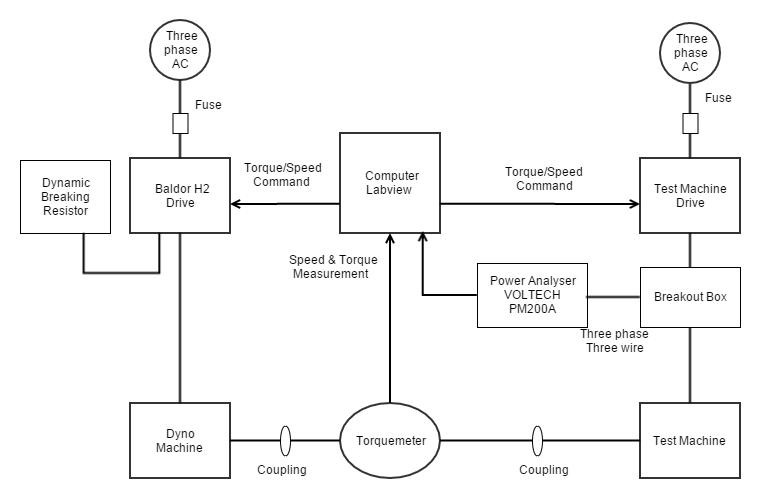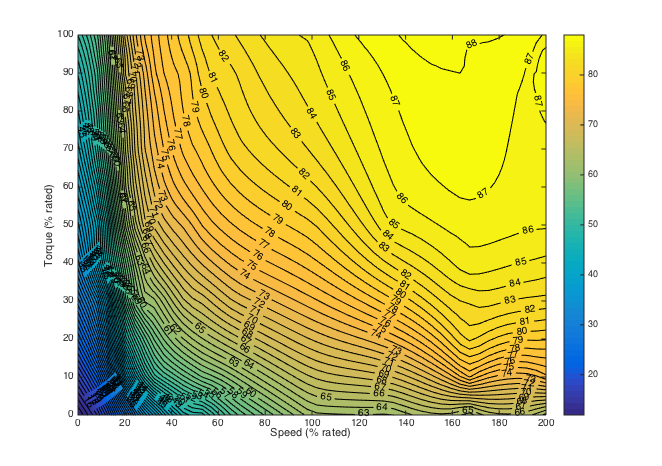Difference between revisions of "Projects:2015s1-61 Computer Aided Measurement and Analysis of Equal Efficiency Characteristics of Electrical Machines"
(→Dynamometer System) |
(→DC Machine) |
||
| Line 29: | Line 29: | ||
== DC Machine == | == DC Machine == | ||
| + | The DC machine tested is a 5kW brushed DC machine. It is connected to a SIEMENS drive and the No-Load test is done. | ||
| + | |||
| + | From this map it has shown some interesting properties of this DC machine. First to notice is that the efficiency map for this DC machine is linear, but it goes bi-directional. In horizontal direction, when the torque is fixed, then the efficiency should be similar for a range of speeds. Nevertheless, for higher efficiency, the speed range reduces as the minimum speed required goes higher, including slightly increasing of torque. For example, from the plot, the 25% efficiency covers speed from about 0 rad/s to 100 rad/s but for 70% efficiency the minimum speed is approximately 60 rad/s and the torque increases from 0.05 Nm to about 0.25Nm. | ||
| + | |||
| + | It is observed that the efficiency is not vertical in y-axis, increasing the efficiency decreases the slope. That means for higher efficiencies, if the speed is maintained, apart from the enclosed region, increasing or decreasing the torque will lower the efficiency dramatically if operates in high efficiency point. | ||
| + | |||
| + | The another aspect is that for DC machines, it is possible to maintain the speed and efficiency by shifting the torque to the upper or lower level whereas the opposite each torque can have a range of speed associate with that efficiency depending on how much efficiency is required. | ||
| + | |||
| + | Based on the findings, it is recommended that for DC machine it is better to operate at rated torque then speed up to the rated speed. The machine efficiency is normally low if running at high load but slow speed. If the load is too low, then no matter how fast the machine is, the efficiency does not improve by accelerating the machine. | ||
== Switched Reluctance Machine == | == Switched Reluctance Machine == | ||
Revision as of 12:02, 23 October 2015
Contents
Project Group 61 information
Topic
Computer Aided Measurement and Analysis of Equal Efficiency Characteristics of Electrical Machines
Team
Student
Ka Kit Poon
Zeyu Chen
Kejie Huang
Supervisor
A. Prof. Nesimi Ertugrul A. Prof. Wen Soong
Aim
The main goals of the project is to explore the iso-efficiency map for a variety of electric machines, including brushed DC machines, switched reluctance machines (SRM) and squirrel cage induction machines (SC IM), compare and analysis the iso-efficiency maps of different types of electrical machine and try to predict the energy consumption for applications which require time-varying torque-speed operation. Iso-efficiency map is a new concept to describe the efficiency at each operating point in the operating region. The process involves machine testing, system setup, data acquisition to obtain the resulted iso-efficiency map to form a comprehensive view of electrical machine efficiency characteristics. The expected iso-efficiency map for electrical machine is similar with K. Stockman’s work [1], this is a typical iso-efficiency map for an induction machine.

Motivation
Iso-efficiency map describes the efficiency of each operating point on the torque-speed operating region. With the iso-efficiency map of each type of electrical machines, industry could predict the energy consumption in particular application and select the most efficient electrical machine, thus energy could be saved. In this project, the team carry out computer aided measurement and plotting of iso-efficiency map. It provided brief image about the efficient operating region of different machine.
Background
Proposed Approach
All electric machine will be tested in the Dynamometer system. One of the PHD student, Gabriel, has built the dynamometer system in the power laboratory at the University of Adelaide. The Machines will be integrated into the system. The development of computer interface for DC and Switched Reluctance Machine is one of major task in the integration. As the DC and SWR machine do not have a software-based interface, an interface board is required to built to allow computer control the drive. The USB DAQ 6009 is selected by the team and supervisor. It is I/O device that can transmit and receive digital and analogue signal.
DC Machine
The DC machine tested is a 5kW brushed DC machine. It is connected to a SIEMENS drive and the No-Load test is done.
From this map it has shown some interesting properties of this DC machine. First to notice is that the efficiency map for this DC machine is linear, but it goes bi-directional. In horizontal direction, when the torque is fixed, then the efficiency should be similar for a range of speeds. Nevertheless, for higher efficiency, the speed range reduces as the minimum speed required goes higher, including slightly increasing of torque. For example, from the plot, the 25% efficiency covers speed from about 0 rad/s to 100 rad/s but for 70% efficiency the minimum speed is approximately 60 rad/s and the torque increases from 0.05 Nm to about 0.25Nm.
It is observed that the efficiency is not vertical in y-axis, increasing the efficiency decreases the slope. That means for higher efficiencies, if the speed is maintained, apart from the enclosed region, increasing or decreasing the torque will lower the efficiency dramatically if operates in high efficiency point.
The another aspect is that for DC machines, it is possible to maintain the speed and efficiency by shifting the torque to the upper or lower level whereas the opposite each torque can have a range of speed associate with that efficiency depending on how much efficiency is required.
Based on the findings, it is recommended that for DC machine it is better to operate at rated torque then speed up to the rated speed. The machine efficiency is normally low if running at high load but slow speed. If the load is too low, then no matter how fast the machine is, the efficiency does not improve by accelerating the machine.
Switched Reluctance Machine
Squirrel Cage Induction Machine
The SC IM is a 2.2 kW Baldor machine. The induction machine is widely used in the industry. The drive used is Motiflex e100. It has a user-friendly interface and facilitate software configuration via "Mint WorkBench". As the manufacture has designed computer interface between drive and computer, the integration into the system does not take much time compared with DC and SWR Machine.
Dynamometer System
Electric Machine is integrated into the dynamometer system. The system facilitate accurate measurement of efficiency. The Dyno machine acts as load and H2 drive controls the torque systemically. The function of computer is to send command to the drives and received data from measurement equipment. The control system monitor measured value and compare with reference value. The computer send speed and torque command to drive until certain condition is achieved.
Reasult - Iso-efficiency Map of SC IM
The Squirrel Cage Induction Machine is integrated and tested in the Dynomometer system. The 10x10 speed amd torque value is measured. The iso-efficiency map has been plotted in MATLAB. The result shows that the machine operate efficiently at relatively high speed and low torque rather than rated value. The lowest efficiency is at low speed. It is found that the efficiency is increasing when higher torque is added to the test machine. One of the limitation is overload operating region. As the machine can only run overload for short time, the data set above rated torque is missing.
Reference
[1] D. Vanhooydonck et al., “Calculating Energy Consumption of Motor Systems with Varying Load using Iso Efficiency Contours”, in XIX Int. Conf. Elect. Mach., Rome, 2010.
[2] W. Deprez et al., “Iso efficiency contours as a concept to characterize variable speed drive efficiency,” in 2010 XIX Int. Conf. on Elect. Mach. (ICEM), Sep. 2010, pp. 1-6.
[3] K. Stockman et al., “Iso efficiency contour measurement results for variable drives,” in 2010 XIX Int. Conf. on Elect. Mach. (ICEM), Sep. 2010. pp. 1-6.

